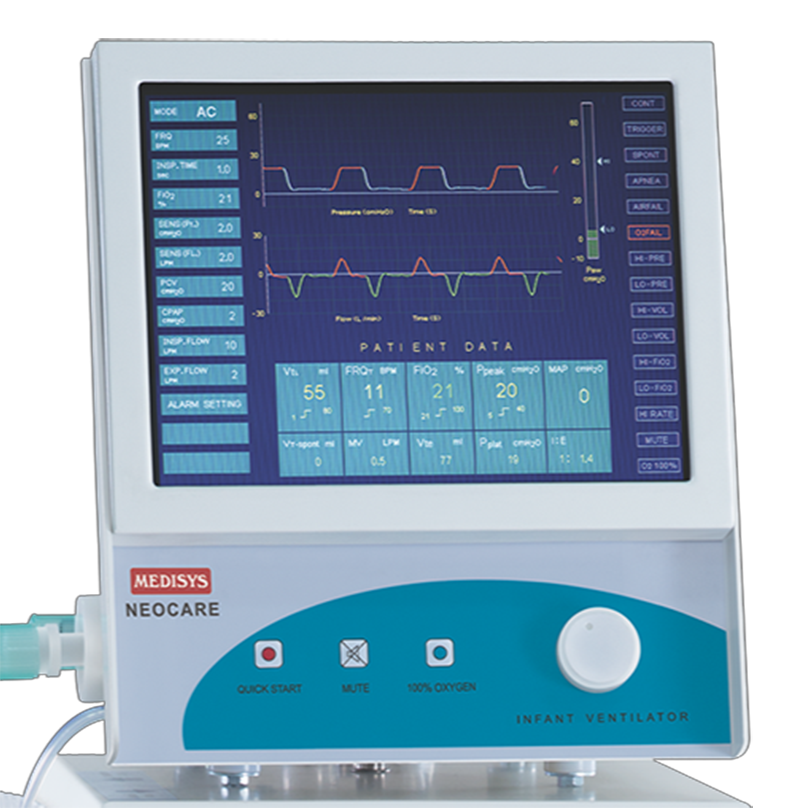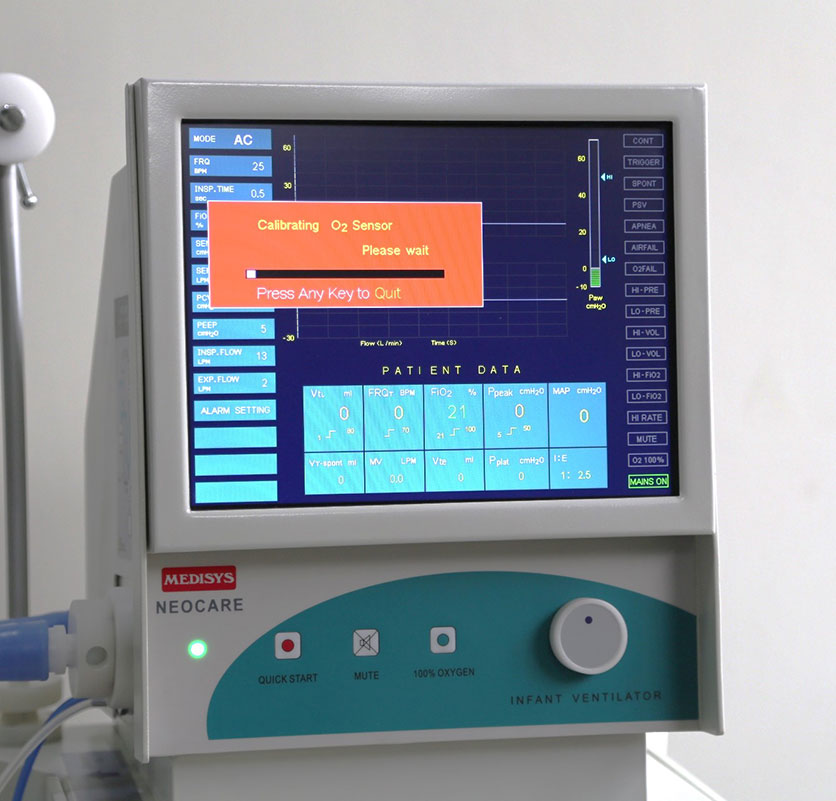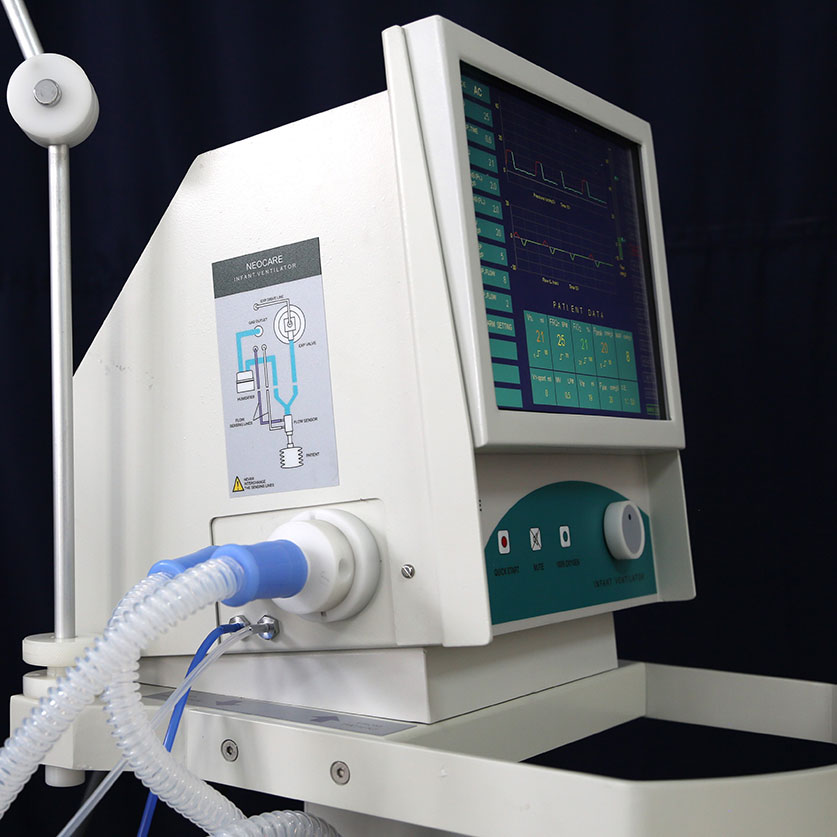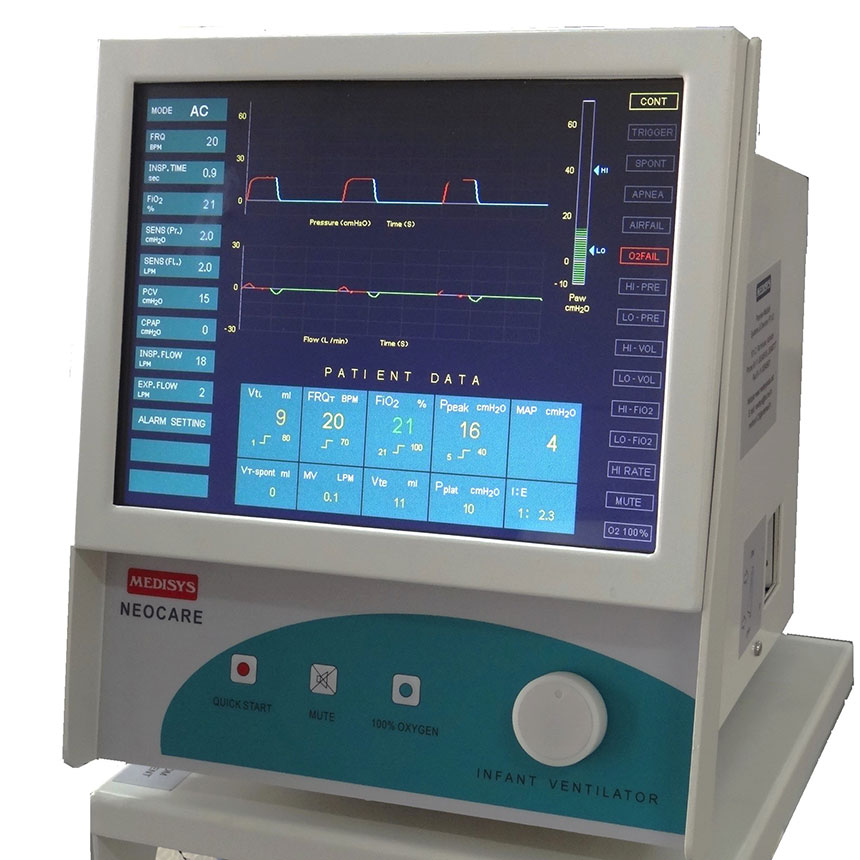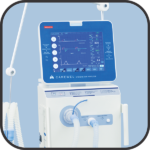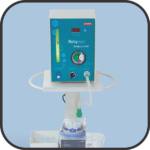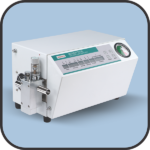Neocare
Paediatric Ventilator
It is an electronically controlled ventilator based on the widely accepted technique of continuous flow and pressure control modes. There is an option to select the inspiratory and expiratory flow separately. Both volume and pressure limiting features have been added to reduce the possibilities of Volume Trauma or Barotrauma. The sensing device at the proximal to the patient gives quick response and sensitive triggering. Both the pressure and the flow triggering are available. The use of closed feedback system has made the control of ventilation very accurate. The provision of independent CPAP mode and PSV makes the device very versatile.
Features
Ventilating newly born babies with continuous flow is a proven technique in view of safety and comfort. With its weak muscle power, the baby can easily breathe in from this continuous flow. Outward movement of flow drives away the exhaled CO2 during expiration.
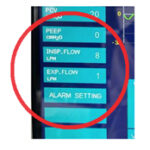
Ventilating with untried tidal volume might have adverse consequences as infants and new-borns have delicate lungs. Controlling the pressure is thus considered safer in view of such consequences of barotrauma/volume-trauma. The modes of ventilation are so all made to pressure controlled.
Considering the very delicate nature of lungs, it is essential to take additional safety measures. The ventilator so provides for limiting the pressure and volume to avoid adverse consequences. The limit of pressure and volume may be set suitably on the panel.
The breathing effort of the patient can be detected by fall in pressure or the flow of gas towards the patient. On detection of either these phenomena, the ventilator initiates the mechanical breath. The triggering is very effective as either of the two factors are considered, instead of only one.
To make the triggering more effective, the sensor has been placed at the proximal of the patient.
Calibration of oxygen cell is desired for monitoring FiO2 correctly as the cell gets affected with continuous exposer to oxygen. The ventilator thus perform the required calibration at the start of the operation. However, the operator has the option to skip.
Blending of air and oxygen is done by precise regulation of the flow of gases with the help of advanced proportional valves. The controller does it depending on the closed feedback provided by the oxygen sensor. The closed feedback makes the blending accurate although outflow may vary widely.
In addition to continuous flow, the ventilator also uses a dynamic demand valve to meet the inspiratory demand of the patient. This enables to maintain the continuous positive airway pressure (CPAP) effectively.
As the CPAP keep lungs partially inflated, the PC level is set suitably for adequate mechanical ventilation.
PSV is available as a combination mode with SIMV. It works by raising the circuit pressure instantly when the patient makes an effort. It makes the gradient for flow of gas into the lung and reduces the WOB. As the inspiratory demand tends to cease, the gradient is withdrawn. PSV is active between the mandatory breaths of SIMV.
When the patient is on support mode, it is supposed to breathe spontaneously. But at times, the patient may fail and the support mode becomes ineffective. To safeguard, it is desired to have a backup control mode to ventilate during the period. The ventilator provides the facility as Apnea Backup. The backup is withdrawn when the spontaneous breathing is restored suitably.
The patient data are monitored on real time basis. The display shows the data in tabulation form at the Centre-bottom of the panel. The patient data clearly shows the limiting values for different parameters also.
| LCD Display 12.1 inches coloured TFT |
| Modes AC, SIMV/IMV, CPAP with backup ventilation & Standby |
| PCV 0 to 40 cmH2O |
| Flow 2 to 25 LPM |
| Frequency 1 to 150 breaths per minute |
| Inspiratory time 0. 2 to 3. 0 seconds |
| Triggering Flow triggering :1 to 10 LPM Pressure Triggering : 0.5 to 8 cmH2O |
| Exp. pressure 0 to 20 cmH2O |
| Insp. Pressure limit 5 to 50 cmH2O |
| Tidal Volume 6 to 300 ml |
| I : E ratio 1:1 to 1:10 (AC ), 1:1 to 1:60 (SIMV); Inverse 1:1 to 4:1 |
| Safety Pressure Relief 15 to 50 cmH2O |
| Alarm mute 30 seconds |
| Alarms High/Low Insp. Pressure, High/Low Tidal Vol, High/Low FiO2, Gas Failure, Apnea |
| Patient Data Frequency, PIP, MAP, Pplat, TV(exp), TV(insp), Spontaneous Exp Volume, MV, FiO2 & I / E ratio |
| Ventilation curves Pressure-Time and Flow-Time |
| Humidifier Heated |
| Power source 220 VAC, 50 Hz |
| Battery backup 6 hours (control module) |


